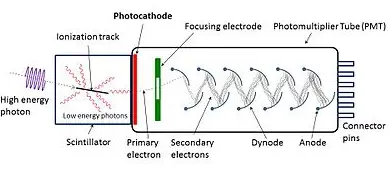A scintillation counter is an instrument for detecting and measuring ionizing radiation similar to Geiger Muller counter and ionization chamber. It uses excitation effect of incident radiation on a scintillator material and detecting the resultant light pulses.
Scintillation crystals are those which produce a brief flash of light each time they are struck by an alpha or beta or gamma radiation. For example, sodium iodide, anthracene, zinc sulphide, naphthalene, etc.
The process of producing a flash of light by striking the scintillation crystals with alpha or beta or gamma particles is known as Scintillation.
Scintillation counter employs this Scintillation principle for detecting and measuring ionizing radiation. The scintillation counter consists of a scintillator and a photomultiplier tube.

Working of Scintillation counter
- Consider fig1. as shown above.
- Whenever, radiation strikes the scintillation crystals present in the scintillator, a tiny flash of light is produced.
- The flash of light is amplified with the help of photomultiplier tube.
- Each radiation particle produces a pulse of anode current at the output of the photomultiplier.
- The output of photomultiplier is connected to an electronic counter which counts each flash light generated by the scintillation crystals.
- The intensity of radiation can be detected by counting the number of pulses.
Advantages of Scintillation counter
- Its counting rate is very fast.
- This instrument is also used to detect X-rays.
- It is more sensitive to Geiger Muller counter.
- It can detect lower levels of radiation.
image reference: en.wikipedia.com
